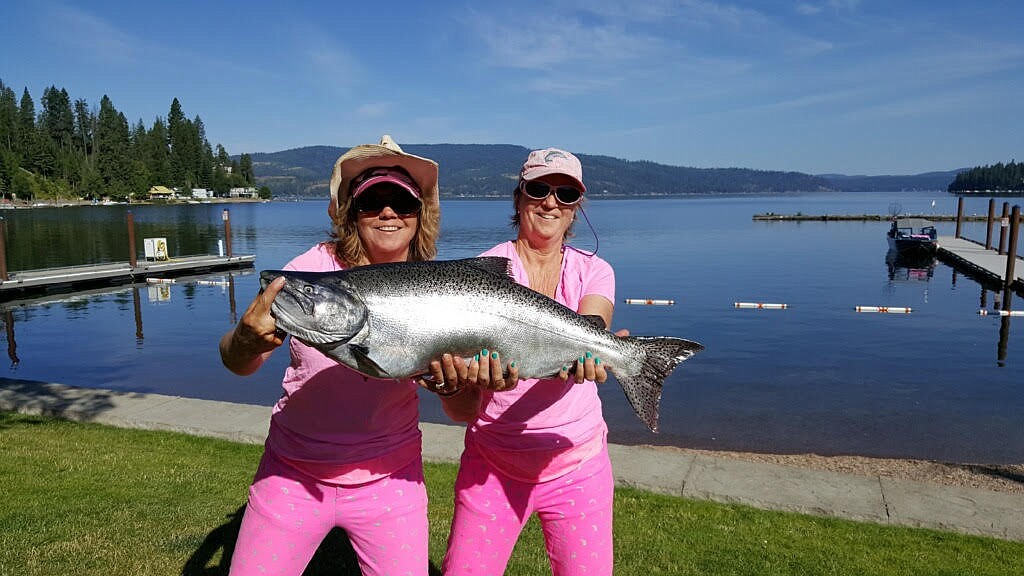No boom or bust in Lake CdA's chinook
COEUR d’ALENE — You won’t find Roger Blackstone’s boat on Lake Coeur d’Alene pushing through the mist with his brace of Weimaraners sleeping on deck as fishing poles bend to the pull of his favorite waters.
Blackstone, one of the lake’s chinook salmon gurus and the chairman of the Lake Coeur d’Alene Anglers Association has flown the coop.
“There’s no fish out there,” Blackstone said.
What he means is his favorite fishery, the lake’s landlocked king salmon — also called chinook salmon — is on the skids.
A derby sponsored by the Lake Coeur d’Alene Anglers usually set for late fall has been canceled in part because of what chinook fishers learned from the latest Big One Derby, which ended two weeks ago: The lake’s kings were few and far between.
Usually this time of year, the big predators have moved toward the lake’s south end as they prepare to run up the Coeur d’Alene River to spawn.
That makes finding the fish less difficult for anglers with a ken for kings, and the late summer fishery is close to home for residents of fishers in Conkling Park, Harrison and Carlin Bay.
Blackstone, and his aluminum boat, The Fish Whisperer, will not be among them.
The Coeur d’Alene resident is heading to Lake Pend Oreille to chase Kamloops rainbow trout — another trophy North Idaho gamefish popular among sport anglers. But he’ll be back for a 7 p.m. meeting Aug. 30 at MacKenzie River Pizza, 405 W. Canfield Ave., Coeur d’Alene, where the Idaho Department of Fish and Game biologists will discuss the state of the lake’s chinook.
Since being planted in the Lake Coeur d’Alene system 30 years ago the landlocked fish have had an up-and-down existence.
High water, angler pressure or their own proclivity for survival have been a boon or a bane for the inland king salmon.
The fish spawn each fall in rivers and streams including the St. Joe and Wolf Lodge Creek. About 5 percent of the lake’s chinook spawn in the St. Joe River, and a couple dozen spawn in Wolf Lodge Creek, while the bulk of the population moves into the Coeur d’Alene River to spawn.
To manage numbers, fisheries biologists in the past destroyed some of their redds — or spawning beds — because big chinook populations need lots of food to survive, and chinook eat kokanee — another, smaller, landlocked salmon and a prize fish among anglers. The kokanee population was too popular to jeopardize.
During high water years, chinook spilled over the Post Falls dam into the Spokane and Columbia rivers, and during high fish years anglers were out in force, often picking them off in places they pooled in the fall, such as the flats at the mouth of the Coeur d’Alene River in front of Harrison.
But the biggest nuisance to afflict a large portion of the lake’s stocked chinook was their genes.
To bolster the wild brood of local spawning fish, IDFG stocks juvenile sea-run hatchery fish. Those speckle-sided chinook don’t like the lake, and often head downstream at the earliest opportunity, leaving only a small population of landlocked wild fish for anglers to chase.
“We’ve been relegated to use anadromous stock fish,” state fishery biologist Carson Watkins said. “We’ve known they have a tendency to leave the lake.”
Watkins will be among IDFG fishery scientists to discuss the lake’s chinook fishery over pizza this month.
Despite fewer fish, the lake’s chinook population is not dire, Watkins said.
“It kind of hovers at a low, but stable number of adults,” Watkins said.
Like his counterpart at the fishery department, Blackstone is upbeat about the future of the lake’s chinook fishery. His club has been providing data they collect at derbies to the department, and it has been working closely with biologists to come up with solutions to increase the number of landlocked chinook.
Raising broodstock from wild Lake Coeur d’Alene fish in a hatchery to supplement the surviving wild stock is among options being considered. Biologists are also discussing using a hatchery in Mullan to raise fish, and stocking more fish at Wolf Lodge Creek to build a northern lake population of chinook.
“We want to stabilize fish at a higher abundance,” Watkins said. “And move late summer and fall fish to the north end of the lake.”
This year’s chinook numbers may be lower, but the health of the lake’s king salmon as evidenced by the fish weighed at last month’s derby, is not in question, Blackstone said.
“The fish we caught were big beautiful chrome fish, and they were healthy,” he said.
Ralph Bartholdt can be reached by email at rbartholdt@cdapress.com.

